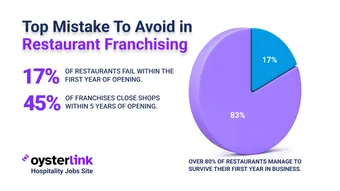Starting your journey as a Server can be both exciting and a bit overwhelming. Mastering the etiquette for Restaurant Servers is essential, as it not only supports your personal success but also ensures that guests have a positive dining experience.
In this guide, we’ll explore everything you need to know about the etiquette for Restaurant Servers, equipping you with the knowledge and confidence to thrive in your new role.
Understanding Etiquette for Restaurant Servers
Etiquette for Restaurant Servers refers to the set of accepted practices and behaviors that define professionalism in the hospitality industry. It's about understanding how to interact with guests, how to present oneself and how to manage various situations that arise during dining service.
Good etiquette is essential for creating a welcoming atmosphere and ensuring that every guest's experience is enjoyable. At its core, etiquette encompasses several key elements, including effective communication, personal presentation and attentiveness to guests' needs.
The Essentials of Server Etiquette
Practicing good etiquette fosters an atmosphere of respect and professionalism, leading to happier guests and, in turn, better tips.
Let’s dive deeper into specific etiquette practices that can enhance your performance and the overall guest experience. Understanding these essential principles of etiquette can make all the difference in the quality of service provided.
1. Personal presentation
As a Server, your appearance reflects the establishment's image. Adhering to the dress code is essential, which often includes wearing a clean and well-fitted uniform, maintaining appropriate footwear and ensuring that your attire is free from stains or odors.
Personal hygiene is key in the restaurant industry. Always remember to prioritize the following practices:
- Arrive clean and well-groomed, with hair neatly styled.
- Keep nails trimmed and free from any polish that might chip off.
- Ensure that any fragrances or perfumes are mild, as strong scents can be off-putting to some guests.
Keep in mind that your body language greatly influences first impressions. Approach guests with an open posture, smile genuinely and make eye contact. A friendly demeanor can set a positive tone for their dining experience.
2. Greeting guests
The initial interaction with guests is vital for setting the tone of their dining experience. Be sure to greet them promptly and warmly — ideally within a minute of their arrival. A friendly “Welcome! How can I assist you today?” can make a significant impact in creating a welcoming atmosphere.
It's also important to acknowledge guests who are already seated in your section, even if you can’t take their order right away. This simple act shows that you value their presence and are attentive to their needs.
3. Menu knowledge
Knowing the menu inside and out is crucial for any Server. Familiarize yourself with all items, including ingredients, preparation methods and specials. This knowledge allows you to confidently answer questions and provide valuable recommendations, which enhance the guest experience.
It's essential to be prepared for inquiries about food allergies and dietary preferences. Always encourage guests to ask questions and be ready to suggest alternatives when necessary. For example, if a guest asks about gluten-free options, you should know which dishes can be modified or easily recommended.
When it comes to upselling, confidence plays a significant role. Use your knowledge to suggest pairings, such as suitable wines for entrées or complementary dishes. This can enhance the guest's meal and potentially increase your tips.
4. Order taking and service techniques
Taking orders efficiently is an integral part of a Server’s role. Ensure to:
- Write down orders accurately while engaging with the guests.
- Repeat orders back to guests to confirm accuracy.
- Prioritize tasks based on the flow of the dining room.
Once the orders are taken, effective serving techniques become essential for creating a professional experience. Serve food from the left and clear dishes from the right, while maintaining eye contact and communicating with guests as you serve.
Being attentive to guest needs is a skill that develops over time. Always keep an eye on details, like when glasses are nearing empty or when a guest looks like they might need assistance. Anticipating needs before guests have to ask significantly enhances their experience, making them feel valued and cared for.
5. Communication skills
Clear and positive communication reflects professionalism. Use a friendly tone, avoid jargon and ensure your guests can easily understand you. Positive body language, such as nodding and maintaining eye contact, shows guests that you are engaged and invested in their experience.
Non-verbal cues can convey just as much — if not more — about your level of service than words alone.
6. Managing difficult situations
No matter how excellent a Server you are, complaints may arise. When faced with a dissatisfied guest, it’s important to remain calm and listen attentively to their concerns. Acknowledge their feelings and show empathy for their situation.
For example, saying, “I’m sorry to hear that you’re not happy with your meal. Let’s see how we can make this right,” demonstrates your commitment to guest satisfaction.
However, some situations may escalate beyond your control. If a guest is especially upset or if the issue is complicated, knowing when to involve a manager is crucial. Approach your manager with a clear explanation of the situation, allowing them to assist in resolving it effectively.
7. Building guest relationships
Making small talk with guests can enhance their dining experience. Simple questions about their day or complimenting their choice of meal can encourage friendly interactions. Just remember to be attentive and gauge when a guest prefers quiet conversation versus engaging dialogue.
One of the most rewarding aspects of being a Server is establishing relationships with regular guests. Try to remember their names, favorite dishes or any special occasions. This personal touch not only makes guests feel appreciated but can also increase their loyalty to the restaurant.
Focus on making every guest’s visit special, and consider little gestures like:
- Offering complimentary items for birthdays or anniversaries.
- Sending a heartfelt thank-you note for special occasions.
- Remembering preferences for their next visit.
8. Closing and farewells
Towards the end of the meal, ensure that you check in one final time to see if guests need anything else. Ask if they would like dessert or coffee. Once their meal is concluded, clear the table in a timely manner to prepare for new guests.
When guests are ready to leave, ensure you thank them for coming and invite them to return. A sincere goodbye can encourage repeat visits and reinforce a sense of loyalty toward the restaurant.
Encouraging feedback is also very important. Let guests know that you value their opinions and would love to hear their thoughts on their experience. Using phrases like “We hope to see you again soon!” or “Thank you for your feedback; it helps us improve” can significantly contribute to building lasting relationships with guests.
Conclusion
Mastering the etiquette for Restaurant Servers is essential for success in the dining industry. From personal presentation to managing guest interactions and building relationships, understanding and practicing these elements will make you a standout Server.
For those looking to enhance their skills further, check out OysterLink. It’s a jobs platform that features current Server openings along with valuable career advice and hospitality insights.









Loading comments...